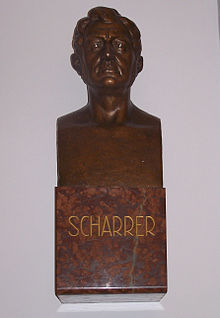Johannes Scharrer

Johannes Scharrer (born May 30, 1785 in Hersbruck ; † March 30, 1844 in Nuremberg ) was an entrepreneur , founder of the municipal savings bank and several educational institutions in Nuremberg.
Life
Johannes Scharrer was born on May 30, 1785 in Hersbruck . The house where he was born can still be seen there today. So much is known of his youth that he attracted attention for his “lively mind, quick perception and great thirst for knowledge”. Therefore, his parents let him attend a Latin school, which he mastered excellently. What was unusual, however, was that Johannes Scharrer did not aim to study, but wanted to do an apprenticeship as a businessman. During his apprenticeship he learned the English , French , Spanish and Italian languages and acquired a comprehensive education which later provided him with a solid foundation in his commercial and public work.
After his apprenticeship he moved to the imperial city of Nuremberg and founded the trading house for hops Scharrer and Amberger with his brother-in-law , which was entirely in keeping with his origin. He was the son of a brewer from the hop town of Hersbruck (the hop trading house Scharrer and Amberger still exists today under the name "HOPUNION"). Scharrer was very successful with his company: the hops were sold as far as London and Ghent in Flanders . In 1826 he withdrew from the hop trade. Johannes Zeltner , who also worked in the hops business, became his son-in-law in 1833.
In Nuremberg it was 1,818 civil magistrate , 1,821 community representative and finally in 1823 the second mayor . At his instigation, the first municipal savings bank was founded in 1821 . In education, there was under his leadership for the establishment of national and civil schools . In 1823 the Polytechnikum (forerunner of today's Technical University of Nuremberg ) was founded on his initiative . Scharrer put the town's shattered finances in order and regulated the conditions of the poor hospitals. The parishioners campaigned for a raise in 1827 because of his valued work in the government. He was seen as too independent in 1829 after a dispute from his mayor's office. King Ludwig then appointed him director of the Polytechnic School. Together with Georg Zacharias Platner, he took part in the negotiations for the establishment of the South German Customs Union in 1828 . In 1832 he was sent to Berlin on the pretext of studying at the Prussian educational institutions . In 1834 he founded the trade school, today's Johannes-Scharrer-Gymnasium .
Scharrer and the first railroad
On February 12, 1833, he joined the preparatory committee for the Ludwigs-Eisenbahn-Gesellschaft , the first railway company in Germany to use a steam locomotive , the Adler, on its route between Nuremberg and Fürth . This company was the first public limited company in Bavaria. Together with mathematics professor Conrad Georg Kuppler, he prepared the cost estimate and settled organizational and technical questions. As deputy director, he was responsible for the operating regulations (corresponds to today's railway building and operating regulations ), the annual report and the instructions for the service personnel. At the end of the first budget year he succeeded Platner as chairman of the railway company, whose resignation took place on December 12, 1836, and headed the company as director until his death.
However, his strenuous and non-stop work finally took its toll: On March 30, 1844, Johannes Scharrer died after a stroke in the presence of his sons. He was buried in the Johannisfriedhof in Nuremberg .
After his death, the Ludwigs-Eisenbahn-Gesellschaft erected a simple memorial in the form of a stele with his bust, cast in ore by Burgschmiet, at the Ludwigsbahnhof am Plärrer in Nuremberg. This bust is now in the Nuremberg Transport Museum .
In 1865 a locomotive belonging to the Ludwig Railway Company was named after him.
Cultural
- On November 6th, 1820 he became member number 362 of the Pegnese Flower Order
literature
- Karl Maximilian von Bauernfeind : Scharrer, Johannes . In: Allgemeine Deutsche Biographie (ADB). Volume 30, Duncker & Humblot, Leipzig 1890, pp. 601-612.
- Rainer Mertens: Scharrer, Johannes. In: New German Biography (NDB). Volume 22, Duncker & Humblot, Berlin 2005, ISBN 3-428-11203-2 , p. 583 f. ( Digitized version ).
- Rainer Mertens : Johannes Scharrer. Profile of a reformer in Nuremberg between the Enlightenment and Romanticism . (= Nuremberg work pieces on city and state history; Vol. 57). Korn and Berg, Nuremberg 1996, ISBN 3-87432-134-7 (also dissertation, University of Bayreuth 1995/96)
- Mück, Wolfgang: Germany's first steam train. The royal privately owned Ludwig Railway between Nuremberg and Fürth . ( Dissertation at the University of Würzburg ), Fürth 1985 (2nd revised edition)
Individual evidence
- ^ Georg Zacharias Platner. Nuernberginfos.de, accessed on December 22, 2019.
- ^ Official anniversary volume of the German Federal Railroad - 150 Years of the German Railroad - Special Edition Economy and Industry , ELV Eisenbahn-Lehrbuch Verlagsgesellschaft, 1985, ISBN 3-923967-05-5 .
- ^ The Ludwigsbahnhof in Nuremberg and Fürth. Nuernberginfos.de, accessed on December 22, 2019.
| personal data | |
|---|---|
| SURNAME | Scharrer, Johannes |
| BRIEF DESCRIPTION | German entrepreneur and politician |
| DATE OF BIRTH | May 30, 1785 |
| PLACE OF BIRTH | Hersbruck (Middle Franconia) |
| DATE OF DEATH | March 30, 1844 |
| Place of death | Nuremberg |




